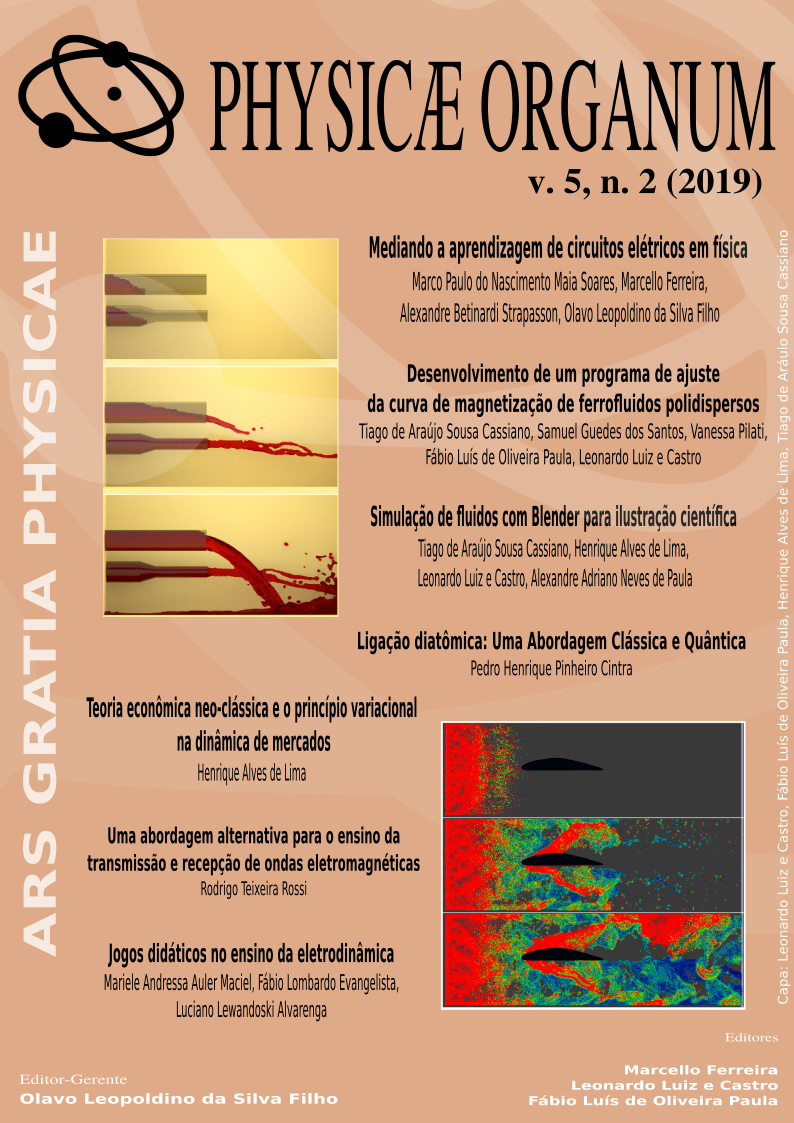Development of a program to fit the magnetization curve of polydisperse ferrofluids
Abstract
A ferrofluid is a colloidal dispersion of magnetic nanoparticles.
Its magnetization curve reflects a competition between the thermal agitation and the tendency of alignment with an applied magnetic field.
The interaction between the magnetic particles becomes smaller as the system is diluted.
Therefore, the magnetization curve of a ferrofluid with low particle concentration can be approximated by the Langevin curve, which describes isolated particles that only interact with an applied magnetic field.
The Langevin curve applies to a system of magnetic particles with equal diameters, that is, a monodisperse ferrofluid.
In a real ferrofluid, however, the particle diameters are different, and are best described by a log-normal distribution.
In this polydisperse system, the Langevin curve must be corrected by an integral weighted by the relative frequency of the diameters in the distribution.
In this work, we present a computer program developed in Java to adjust the magnetization by the generalized Langevin curve, calculated by means of numerical integration.
The program has a graphical interface that allows easy use by experimental researchers.
References
ANDREO, P. Monte carlo techniques in medical radiation physics. Physics in Medicine and Biology, IOP Publishing, v. 36, n. 7, p. 861”“920, jul 1991. Disponível em:
<https://doi.org/10.1088%2F0031-9155%2F36%2F7%2F001>. 19
CASTRO, L. L. e. Simulação Monte Carlo de fluidos magnéticos voltados a aplicações tecnológicas e biomédicas. Tese (Doutorado) ”” Universidade de Brasília, Brasília, 2009. 19, 20
DASKALOV, G. M.; LöFFLER, E.; WILLIAMSON, J. F. Monte carlo-aided dosimetry of a new high dose-rate brachytherapy source. Medical Physics, v. 25, n. 11, p. 2200”“2208, 1998. Disponível em: <https://aapm.onlinelibrary.wiley.com/doi/abs/10.1118/1.598418>. 20
GAMMA, E.; HELM, R.; JOHNSON, R. E.; VLISSIDES, J. Design Patterns: Elements of Reusable Object-Oriented Software. [S.l.]: Addison-Wesley, 1995. (Addison-Wesley Professional Computing Series). 21
GRANQVIST, C. G.; BUHRMAN, R. A. Ultrafine metal particles. Journal of Applied Physics, v. 47, p. 2200, 1975. 19
GRIFFITHS, D. J. Introduction to Electrodynamics. Nova Jersey: Prentice Hall - Upper Saddle River, 1999. 16, 17
ISRAELACHVILI, J. Intermolecular e surface forces. Londres: Academic Press, 1992. 17
MAHONEY, D. G.; HELGELAND, W. Magnetic fluid seal with precise control of fluid volume at each seal stage. [S.l.]: Google Patents, 2017. US Patent 9,816,617. 15
MANDL, F. Statistical Physics. Chichester: John Wiley & Sons Ltd., 1980. 17
MAVER, U.; BELE, M.; MAKOVEC, D.; CˇAMPELJ, S.; JAMNIK, J.; GABERÅ Cˇ EK, M. Incorporation and release of drug into/from superparamagnetic iron oxide nanoparticles. Journal of Magnetism and Magnetic Materials, Elsevier, v. 321, n. 19, p. 3187”“3192, 2009. 15
METROPOLIS, N.; ROSENBLUTH, A.; ROSENBLUTH, M.; TELLER, A.; TELLER, E. Equation of state calculations by fast computing machines. Journal of Chemical Physics, v. 21, p. 1087, 1953. 19
ROSENSWEIG, R. E. Ferrohydrodynamics. Mineola, Nova York: Dover, 1997. 15, 16, 17, 18, 19
SATO, M.; YAMASHITA, T.; OHKURA, M.; OSAI, Y.; SATO, A.; TAKADA, T.; MATSUSAKA,H.; ONO, I.; TAMURA, Y.; SATO, N.; SASAKI, Y.; ITO, A.; HONDA, H.; WAKAMATSU, K.; ITO, S.; JIMBOW, K. N-propionyl-cysteaminylphenol-magnetite conjugate (nprcap/m) is a nanoparticle for the targeted growth suppression of melanoma cells. Journal of Investigative Dermatology, v. 129, n. 9, p. 2233 ”“ 2241, 2009. 15
S.S, P. Low viscosity magnetic fluid obtained by the colloidal suspension of magnetic particles. 10 1965. 15
Downloads
Published
Issue
Section
License
Autores que publicam nesta revista concordam com os seguintes termos:
Autores mantém os direitos autorais e concedem à revista o direito de primeira publicação, sendo o trabalho simultaneamente licenciado sob a Creative Commons Attribution License o que permite o compartilhamento do trabalho com reconhecimento da autoria do trabalho e publicação inicial nesta revista.
Autores têm autorização para assumir contratos adicionais separadamente, para distribuição não-exclusiva da versão do trabalho publicada nesta revista (ex.: publicar em repositório institucional ou como capítulo de livro), com reconhecimento de autoria e publicação inicial nesta revista.
Autores têm permissão e são estimulados a publicar e distribuir seu trabalho online (ex.: em repositórios institucionais ou na sua página pessoal) a qualquer ponto antes ou durante o processo editorial, já que isso pode gerar alterações produtivas, bem como aumentar o impacto e a citação do trabalho publicado (Veja O Efeito do Acesso Livre).




